|

活動:2009國際天文年 通俗演講
講員:Geoffrey W. Marcy教授(美國 加州大學伯克萊校區天文系)
講題:
The Search for Earths and Life in the Universe
(尋找新地球及外星生命)
|

|
時間:2009年5月25日
(星期一)15:10-17:00
地點:台南市
成功大學
成功校區
格致廳小講堂 (理化教學大樓地下一樓)
主辦單位:中華民國天文學會、成功大學理學院、成功大學物理系、成功大學太空天文與電漿科學研究所
簡介:
從1995年底至今,天文學家已經「找到」300多顆外太陽系行星,其中七成以上的發現,來自Marcy教授所領導的團隊。在此演講中,Marcy教授將針對「偵測外太陽系行星」、「尋找宇宙中的新地球」、及「尋找外星文明」等三個主軸,進行深入淺出的介紹。
Professor Geoff Marcy小傳:
傑佛瑞‧馬西(Geoffrey
Marcy)是加州大學柏克萊分校教授、舊金山加州州立大學物理和天文系兼任教授、及柏克萊綜合行星科學中心主任。
馬西教授於1976年取得加州大學洛杉磯分校之物理學和天文學雙學士,之後於1982年於加州大學聖塔克魯茲分校取得天文學及天體物理哲學博士學位。除於2002年獲選為美國科學院為院士之外,更於2005年榮獲「邵逸夫天文學獎」的殊榮(天文學的諾貝爾獎)。
在十六世紀,哥白尼指出恆星都是它處的太陽,而可能也皆有行星繞行的想法。1995年在Michel Mayor和Didier Queloz宣佈發現了第一顆外太陽系行星後,馬西教授團隊馬上用開創性的觀測方法加以證實。到目前為發現的300多顆外太陽系行星中,馬西教授團隊的貢獻其中的七成以上,並為系外行星的質量、軌道距離、軌道偏心率提供了統計上可靠的資訊,除此之外,他的團隊發現有五顆行星環繞鄰近恆星「55 Cancri」,這使得位於巨蟹座中心的55 Cancri是除了太陽以外,已知擁有多顆行星的唯一恆星,同時亦大幅增加宇宙它處可能有地球這類行星的可能性。
Geoff Marcy attended public schools in
Los Angeles
from 1959 to 1972. His favorite classes were chemistry and physics in high
school, where he played cello in the orchestra and competed on the tennis and
track teams. Attending UCLA, he was inspired by many professors including Ray Orbach, George Abell, and Mike
Jura. He attended graduate school at the University
of California at Santa Cruz where his primary advisor was Dr.
George Herbig for five years.
Herbig
took Geoff to the Lick Observatory "120-inch" telescope every month where he
learned observational techniques, especially stellar spectroscopy. Meanwhile, a
young professor, Steven Vogt, built new, high resolution spectrometers and
detectors that ultimately would make planet detection possible. Geoff's Ph.D.
dissertation involved measuring the Zeeman effect in Sun-like stars. He then accepted a Carnegie
Fellowship at the "Mt. Wilson and Las Campanas
Observatories" in Pasadena.
While there, he decided to hunt for planets around other stars. Geoff took a
faculty position at San Francisco
State
University
where he met a sharp student, Paul Butler. They developed a new technique, based
on iodine gas, to measure Doppler shifts of stars to a precision3 meters/sec.
In 1995, Michel Mayor and Didier Queloz announced the first extrasolar
planet. Marcy and Butler
confirmed it within a week, and then used their iodine technique to discover
planets orbiting 70 Virginis and 47 Ursae Majoris within two months.
Within two years, Marcy and Butler
found 10 more planets. By 2007 they had found another 140 planets, providing the
first statistically robust information about the masses, orbital distances, and
orbital eccentricities of other planets. In 1999, Marcy and Butler, working with Debra
Fischer, discovered the first multiple-planet system (upsilon Andromedae) which had the clear architecture of a planetary
system. They also co-discovered a transiting planet crossing in front of HD
209458. They later found the first Saturn-mass and Neptune-mass planets. These extrasolar planets have sparked a new search for habitable
worlds, using spaceborne telescopes, notably "Kepler", the "Space Interferometry
Mission", and the "Terrestrial Planet Finder", each designed to detect
Earth-like planets in different domains of parameter space.

